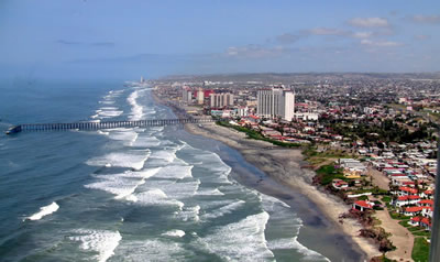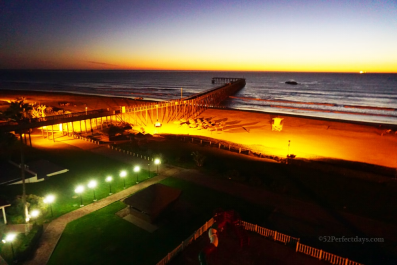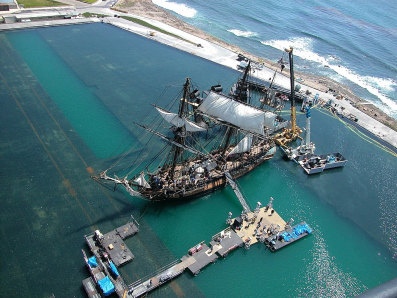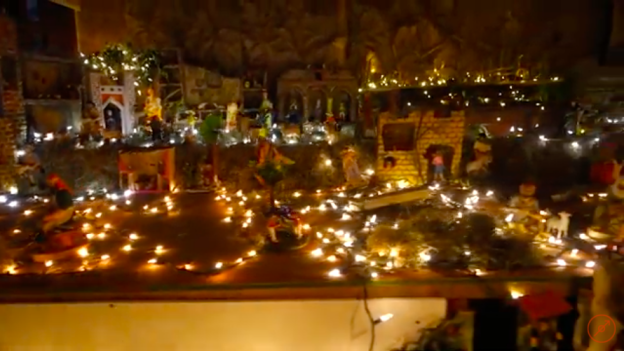Playas de Rosarito, Baja California 作者: 来源: 发布时间:2021-11-10
1.Population and Area
Pop: 70,250 (city)
Area: 513.32 km2 (munip.)
Elev: 14 masl

Rosarito location in Mexico within the state of Baja California
https://goo.gl/maps/o4EeobNe28NLMEqp7
2. Natural geography
Nature and weather
Orography
The area is basically made up of an area of gentle hilly plains and slopes of the mountain units, with a great variety of slopes in which those less than 10% predominate.
Most of the municipal territory is made up of littoral-type soil formed by loose materials that accumulate due to the action of waves and ocean currents; These so-called expansive soils have poor drainage, which represents problems for development.
Among the mammals distributed throughout the Municipality are the black-tailed hare, audobón rabbit, bush rabbit, douglas squirrel, coyote, gray fox, weasel and striped skunk; The bighorn sheep can be found in the vicinity of the rumorosa, as well as the lynx, puma and deer.

Hydrography
The municipality is located in the hydrographic region number 1 of Baja California. This basin is divided into 21 sub-basins, the most important of which correspond to the Rosarito and Huacuatay streams.
Flora and fauna
The predominant vegetation is composed of bushes, rosemary, poplar, bitter chamizo, willow, alder, oak, agave, barrel and velvety cactus, rush, chaparroso, top, sweet mangrove, jojoba, sperm, tule and other species.
In the fauna, the scorpion lizard, the puma, the desert foxes, the blind mole, the squirrel, the shrew, the sheep, the bighorn, the Monserrat and San Lorenzo mouse, the coyote, the bat, the wild cat and mule deer.
http://www.elclima.com.mx/ubica_a_tecate.htm#:~:text=Flora%20y%20fauna&text=En%20la%20parte%20noroeste%20del,culebra%20y%20v%C3%ADbora%20de%20cascabel.
Köppen Classification: Tropical and Subtropical Steppe Climate
This climate type occurs primarily on the periphery of the true deserts in low-latitude semiarid steppe regions. It is transitional to the tropical wet-dry climate on the equatorward side and to the mediterranean climate on its poleward margin, with a cooler, wetter winter resulting from the higher latitude and mid-latitude frontal cyclone activity. Annual precipitation totals are greater than in tropical and subtropical desert climates. Yearly variations in amount are not as extreme as in the true deserts but are nevertheless large.
The Köppen Climate Classification subtype for this climate is "BSk". (Tropical and Subtropical Steppe Climate).
The average temperature for the year in Playas de Rosarito is 62.6°F (17°C). The warmest month, on average, is August with an average temperature of 69.6°F (20.9°C). The coolest month on average is February, with an average temperature of 57.7°F (14.3°C).
The highest recorded temperature in Playas de Rosarito is 106.7°F (41.5°C), which was recorded in September. The lowest recorded temperature in Playas de Rosarito is 32.0°F (0°C), which was recorded in November.
The average amount of precipitation for the year in Playas de Rosarito is 10.3" (261.6 mm). The month with the most precipitation on average is March with 2.2" (55.9 mm) of precipitation. The month with the least precipitation on average is June with an average of 0.0" (0 mm). In terms of liquid precipitation, there are an average of 35.4 days of rain, with the most rain occurring in March with 6.9 days of rain, and the least rain occurring in July with 0.0 days of rain.
https://www.weatherbase.com/weather/weather-summary.php3?s=982017&cityname=Playas+de+Rosarito%2C+Baja+California%2C+Mexico&units=
Getting there and around
Get there
Public transportation
Take public transit (Blue Line trolley from Downtown San Diego), walk across the border, and take a local shared taxi to Rosarito Beach. Visa not needed, and you can get back in USA using your driver's license or passport. Cost $2.50 for trolley, 18-20 pesos ($1.50) for 25 km or so to Rosarito, 45 mins. These are yellow, shared taxi vans (with regular stops) that will take you from Zona Centro in Tijuana, to Rosarito. The shared taxis are located on Francisco I Madero, one block over from Av. Revolucion, in an alley between Carillo Puerto and Calle 4ta.
Taxi
For about $15 you can take a private taxi to Rosarito (direct, no stops) Some Taxi Drivers may charge more, though.
By car
If you are planning to drive here, first thing, buy liability insurance. This can be purchased online 1 or at numerous agencies at the border in San Ysidro. If you don't buy it, have fun in jail. Even if the accident is not your fault, you will be held until that's cleared. Even if you hit livestock on the road, you the driver are at fault. Liability ensures the cow's owner is compensated. Also, arrive early most check in times are around eleven and on busy holiday it will be very hard to find a room. The mexican cops prey on american plates so go early.
Rosarito Beach is easily accessed via a toll road that runs along the Pacific Ocean. The drive around Tijuana can be daunting. Follow the signs on the freeway, but be careful the signs usually appear only at the turnoffs. Don't expect any notices before the turnoffs.
When returning there is an unmarked u-turn in Tijuana you need to take to get back to the States. It's at an interchange next to a Pemex station. Look for a line of cars with American plates making a u-turn.
There are 2 main roads to Rosarito coming from Tijuana/San Diego.
The Toll Road (Mexico 1D - Cuota) is much easier and faster on getting to Rosarito. After crossing the border get into the 3rd lane (counting out from the median), in about 100 meters you'll be on an overpass and a 4th lane will bring on merging traffic, move over to the 4th lane and an offramp to the right will take you to the Via International/Carretera Mexico 1D. This is the main highway to take you to Rosarito, Ensenada, and the western part of Tijuana (Las Playas). If you keep your eye out for signs that indicate any of these three locations it is easier to drive in Mexico, but remember that the toll (cuota) and free (libre) route often split from the same road so may careful attention to the signs to avoid taking the wrong road. The toll cost will be about $30 (about US$2.50) each way.
The Free Road (Mexico 1 - Libre) goes through Tijuana and can be harder to follow.By bus – there is a direct bus departing from Tijuana Bus Terminal and arriving at Tecate. Services depart three times a day, and operate every day. The journey takes approximately 45 min.
https://wikitravel.org/en/Playas_de_Rosarito
Car Rental – To explore Mexico’s provincial towns and cities—including its beach locations and the scenery and attractions near them— consider renting a car for your visit. Having your own car will give you more flexibility than using public transport options and, in some cases, offer you access to places which are otherwise difficult to visit without the use of a car.
COVID19 - International entry into Mexico from United States
Allowed for: All visitors arriving by air. Mexico land borders are closed to non-essential travel
Restricted for: There are no current restrictions.
Get around
By foot – The whole tourist industry lies on Benito Juarez, the main street in town. There's plenty of taxis as well. You're never without friends or drinking buddies as long as you have cash.
It is safe to walk around during the day. As with any new place, make sure you’re alert and aware of your surroundings. There is no standard height for curbs and the sidewalks are full of cracks, so keep your eyes scanning around and below you.
At night, it’s recommended to drive or take an Uber or taxi, which are safe and reasonably priced. You can ask for a restaurant or hotel to call a cab for you. If you choose to drive, street signs are well-lit, and you won’t have heavy traffic to contend with.
Taxis – Taxis in most of Mexico’s towns and cities are not metered, so agree your price before you get in. Taxi travel is very affordable in Mexico, in comparison to the USA, Canada and Europe, and so provides a viable means of public transportation in Mexico. Your hotel can arrange taxis for you; some post their rates on a board in the lobby; taxi hotel rates are usually higher than cabs you hail off the street. If you speak Spanish, you will have a distinct advantage and be able to negotiate a price with the driver.
Uber is expanding rapidly across Mexico and now offers services in cities across the country, including: Mexico City, Toluca, Cuernavaca, Puebla, Querétaro, León, Aguascalientes, San Luis Potosí, Guadalajara, Monterrey, Hermosillo, Tijuana, Mexicali, and Mérida. Uber has been adding Mexican cities to its network every year, check for availability when you arrive at your destination in Mexico.
Cabify and Didi are also developing and currently operate in cities including Mexico City, Toluca, Monterrey, Puebla, Querétaro and Tijuana. Check for availability in the city you are visiting.
These services offer people with smartphones a way to book a cab through a mobile app for a pre-agreed price. Fares are comparable with Sitio type cabs, and sometimes trade at a premium to this when local demand increases.
https://www.mexperience.com/transport/taxi-travel-in-mexico/#51
3. ECONOMY
GDP: 900 M USD (2014)
http://app.cemdi.org.mx/Content/Files/Publications/print_W.BOOK%20ROSARITO-%20V2.pdf
4. Industry characteristics
The Benito Juárez Thermoelectric Plant, the Pemex Storage and Distribution Plant stand out for their importance. The recent installation of a first-class electronic maquiladora industry has generated an expectation of job creation, which to date is in the 1st stage of operation.
Tourism
Due to its natural conditions, the municipality has its own places for tourist development that began at the beginning of the century with the construction of the first hotels in 1925 and 1927, parallel to this fact, the establishment of shops and crafts began. This activity has been consolidated over the last decades. Tourism is undoubtedly the center of gravity of the economic activities of the new Municipality, with its extensive and beautiful coastline, with its sandy beaches and cliffs, climate, modern hotels, first-class restaurants, tourist developments at the height of any city, Mexican crafts, popular festivals, civic, historical, religious commemorations, etc.
Tourism contributes approximately 34.4% of the income received by the Municipality. The establishment of the Fox film studios, where the movie “Titanic” was filmed, and the Calafia Historical and Cultural Center have strengthened the municipal tourist attraction to the South, in the Descanso region.
https://es.wikipedia.org/wiki/Municipio_de_Playas_de_Rosarito
Key project: Playas de Rosarito Desalination Plant
The project includes the construction and operation of a seawater desalination plant with a capacity of 4,400 liters per second in two stages, with a contract term of 40 years, three for construction and 37 for operation.
Construction of the first phase of a desalination plant in the municipality of Playas de Rosarito in Mexico's Baja California state is reportedly set to begin early next year.
The investment is of 10,000 million dollars and the operational start is scheduled for the end of 2019, based on technical principles of efficiency, technology and optimal energy consumption.
The financing is secured through a trust that guarantees the payment of the consideration through a contingent line of credit, in which no government resources will be involved or requested.
The future impact projects to satisfy current water services and cover all demand, less dependence on the Colorado River, additional water for the Mexicali valley, among many others.
https://www.eleconomista.com.mx/estados/Desalinizadora-en-Playas-de-Rosarito-en-desarrollo-20181125-0068.html
https://www.bnamericas.com/es/reportajes/construccion-de-desalinizadora-rosarito-comenzara-en-2020
5. Attractions
Beach strolls

Rosarito Beach used to be reserved for Hollywood’s film sets, but today everyone from locals to vacationers enjoy the sand and sea. The main beach is wide and long. It’s great for taking a stroll or for a jog.
Of course, it’s also a great place to relax and soak up some rays. In summer, the water is warm enough for swimming and you might even find enough waves for boogie boarding.
Here you’ll find vendors selling everything from Mexican blankets to food and jewelry. The vibe is laidback and the sunshine is nonstop.
You can also take a stroll at sunset and enjoy one of the best views you’ll ever see.
https://bajanorte.com/en/a-stroll-on-the-fascinating-history-of-the-magical-town-of-tecate
Art galleries

There are several art galleries in Rosarito. A must see for Rosarito’s art fans is Polo’s Gallery. It’s been open for an impressive 25 years and is home to 15 artists’ original work from Baja. There are also pieces by international artists.
La Carreta, found in the Artisinal Corridor, is a family-run custom handmade furniture store that has been in business for 47 years. Thanks to La Carreta, Rosarito has become famous for handmade furniture. Bring a photograph of something you’d like made and they will craft it for you.
Monte Cristo’s Art Gallery is another studio not to miss. He focuses on equilibrium and balance in his work and uses a signature line down the center of every person in his paintings to symbolize imbalance.
If welding is your catches your interest, La Iguana is a metal furniture store owned and run by Edgar, who is also the mayor of Rosarito. He uses rod iron from Guadalajara to make everything from beds, chairs and patio furniture, to doors and lamps. Edgar learned carpentry from his grandfather and today he makes cold-forged welding by hand.
As you wander in and out of the galleries, you’ll find that many of the artists are hard at work on their next piece. It’s a great opportunity for any art lover to see a piece come to life.
https://52perfectdays.com/articles/best-things-to-do-in-rosarito-beach-mexico
Baja Studios

Baja Studios, formerly Fox Baja, is an American-owned film studio near the resort community of Rosarito, Baja California, Mexico. It comprises the world's largest stages and water tanks designed for filming. As well as major film work the facility is used for making commercials, music videos, television series, and movies for television.
Originally built for Twentieth Century Fox for the reconstruction of RMS Titanic in the 1997 film Titanic, it has since then built some of the largest sets for numerous other studios including, MGM's Tomorrow Never Dies, Amblin Entertainment's In Dreams, Warner Bros.'s Deep Blue Sea, Phoenix Pictures's Weight of Water, Disney's Pearl Harbor and Fox's Master and Commander: The Far Side of the World.

VISITING ROSARITO, MEXICO | ATVs, Tacos, Margaritas
https://youtu.be/uC2x2TPAAig
6. History
Prehistory
Evidence of the presence of Paleo-Indians in the region has been dated as early as 2,000 BC By 1,000 BC, a group emerged that is recognizable as the Yuman ancestors of the Kumeyaay, who continued to inhabit the northern portion of the Baja California Peninsula at the time of European contact.[4] The Kumeyaay referred to the area now known as Rosarito Beach as Wa-cuatay, which translates to "big houses" in the Kumeyaay language.
European arrival and missions
After conquering the Aztec Empire, Hernán Cortés sent expeditions to explore what he believed to be the Island of California. In 1533, mutineer Fortún Ximénez was the first European to land in Baja California, at La Paz, Baja California Sur. In September 1542, Juan Rodríguez Cabrillo passed through the Rosarito Beach area on his way from Ensenada to San Diego Bay. The year of 1697 saw the establishment of the first permanent European settlement in Baja California in a Jesuit mission at Loreto. Rosarito would soon be caught in a power struggle between Jesuits, Dominicans, and Franciscan friars for decades.
In 1773, a frontier was defined separating Nueva ("new") or Alta ("upper") California, under the jurisdiction of the Franciscans, from Antigua ("old") or Baja ("lower") California, which was entrusted to the Dominicans. In 1788, Luis de Sales, a Dominican priest, redrew the boundary, extending Baja California to the Rosarito Arroyo, known at the time as the Barrabas Arroyo.
Because Mission San Miguel, 13 kilometres (8.1 mi) to the south, was frequently flooded by the Río Guadalupe, Dominican missionary Tomás de Ahumada sought another site on higher ground for at El Descanso. Additional advantages of the northerly location were good grazing and plentiful arable land. In 1817, Ahumada founded the Misión El Descanso or Misión San Miguel la Nueva among the Kumeyaay people 22 kilometres (14 mi) to the south of the present-day Rosarito Beach.
In 1830, Father Félix Caballero constructed an adobe church here and managed both missions from El Descanso, but in 1834, it ceased to function as a mission. At the time it had a population of just 254, including those from Mission San Miguel. By 1853 the mission was deserted. Ruins of Misión El Descanso remain within the community of El Descanso.
Ranching Era
The property of Rancho El Rosario, granted by José María de Echeandía in 1827 to Don José Manuel Machado, one of the first soldiers stationed at the Presidio of San Diego, was the first ranch in the modern-day Rosarito region.[5] The 11 league rancho was bounded on the north by Rancho Tía Juana, on the west by the Pacific Ocean and on the south by public lands. Subsequently, his son, Don Joaquín Machado, applied for title to the land as Rancho Rosarito to President Porfirio Díaz. On May 14, 1885, Machado received his title and registered it in Ensenada, then the capital city of the Northern District of Baja California Territory. May 14 is now recognized and celebrated as Rosarito's Foundation Day by the Historical Society of Rosarito.
Modern era
On December 1, 1995, Rosarito was converted from a suburb of Tijuana, to an independent city. Hugo Torres Chabert, current owner of the Rosarito Beach Hotel led the incorporation drive and was subsequently appointed to a three-year term as Mayor.
Playas de Rosarito lies on the coast of the Pacific Ocean on the North Baja California Peninsula. The city is positioned between the foothills of the Peninsular Ranges and the ocean. It maintains a relatively uniform topography and displays few variances in terrain.
Cityscape
Urbanization in 1950 marked the beginning of Rosarito's contemporary-era development as planning and construction of streets and city blocks took place. As land sales soared, coupled with the construction of small restaurants, some shops and two hotels, the city began to take shape its present-day appearance. In the 1960s, Playas de Rosarito entered the commercial and industrial era with the constructions of a large thermoelectric power plant and the later installations of Pemex, the state-owned petroleum company.
The city maintains luxury resorts that take the form of skyscrapers on its coast. The majority of these buildings are located on Boulevard Benito Juárez, also the city's main Boulevard. Residential and commercial highrises continue to go up along the coast, towards both Tijuana and Ensenada.
7. Other Information
Commentary: As an expat in Mexico, I’ve seen the nation take the coronavirus pandemic in stride
My friends from New York City, where I lived for many years, often ask me why I live in Baja California, Mexico, near Rosarito Beach. After we announced that we were moving here, one of them asked my wife whether I had had a stroke. “Not so,” I said. “I moved to Mexico for the people.”
The effusiveness of the Mexican people has certainly been tamped down by the pandemic, but you can still see the friendliness in the eyes above their face masks. They are taking the coronavirus seriously.
Our favorite restaurants are only available for takeout. One of them, Ollie’s Pizza, didn’t permit takeout before the pandemic. You had to enjoy your pizza inside. Many of us go now and the pizza is brought to the car. The owner is sad about this, but he, like so many others, is determined to comply with the rules.
When you see noncompliance, bars in Puerto Nuevo or a gathering on a beach, you tend to find U.S. citizens who have ignored the laws in both Baja and California to come down to party. These are the ones who believe they can do anything they want in Mexico. Their favorite activities are drinking and shouting. Now they’re stunned that no one wants them here, and those who cater to them are shunned. It is shameful to the U.S. expats who live here that their fellow citizens feel they are entitled to jeopardize the health and lives of the Mexican people.
The Calimax near Puerto Nuevo is the Vons of Mexico. It’s a safe place to shop. One waits at the door before entry, a line like one behind a bouncer at a New York nightclub but with each person separated by six feet. I’ve seen women, not hulks in T-shirts and blazers inside the door, wearing virus armor and wiping the handle of a grocery cart with disinfectant. Before the employee gives you the cart, she squirts the Mexican equivalent of Purell in your hands. It’s mandatory.
The Calimax is more spacious than a New York City grocery store; you don’t have to walk sideways down the aisles. It makes me wonder how they can possibly manage social distancing in New York stores. In Mexico, the grocers move politely to the side when you approach. There is a giant table of avocados, much less expensive than those in New York City, if you can even find them there. Guacamole may be a U.S. delicacy, but Mexicans eat avocados chopped up with tomatoes and cilantro. In Mexico, you can buy a dozen avocados for the same price as a single serving of guacamole made at your table in a trendy New York restaurant.
https://www.sandiegouniontribune.com/opinion/story/2020-04-23/expat-mexico-rosarito-beach-coronavirus-commentary
8.Contact Information

City Mayor: Araceli Brown Figueredo
Contact number: +52 (661) 614 9600, ext. 2001
Govt. Office Address: Calle José Haroz, Aguilar No. 2000. Fracc. Villa Turística, C.P. 22710, Playas de Rosarito, B.C.
FB: https://www.facebook.com/YoSoyBROWN
Instagram: https://www.instagram.com/aracelibrownfigueredo
Website: http://www.rosarito.gob.mx
E-mail: abrown@rosarito.gob.mx
